Book contents
- Frontmatter
- Dedication
- Contents
- List of Illustrations
- Preface
- Acknowledgments
- List of Abbreviations
- Introduction: Medievalizing Time
- 1 The Christian and Not-So-Christian Year
- 2 Medievalist Calendar Experiments
- 3 Christmas Becomes a Season
- 4 Winter Love: St Agnes and St Valentine
- 5 Rites of Spring: Imagining Origins
- 6 Summer Festivals: Religion in Performance
- 7 Fragmented Autumn: Harvest-Home to Lord Mayor's Show
- Epilogue: Christmas Ghosts
- Bibliography
- Index
- Miscellaneous Endmatter
4 - Winter Love: St Agnes and St Valentine
Published online by Cambridge University Press: 09 February 2021
- Frontmatter
- Dedication
- Contents
- List of Illustrations
- Preface
- Acknowledgments
- List of Abbreviations
- Introduction: Medievalizing Time
- 1 The Christian and Not-So-Christian Year
- 2 Medievalist Calendar Experiments
- 3 Christmas Becomes a Season
- 4 Winter Love: St Agnes and St Valentine
- 5 Rites of Spring: Imagining Origins
- 6 Summer Festivals: Religion in Performance
- 7 Fragmented Autumn: Harvest-Home to Lord Mayor's Show
- Epilogue: Christmas Ghosts
- Bibliography
- Index
- Miscellaneous Endmatter
Summary
JOHN KEATS's 1820 poem “The Eve of Saint Agnes” is a medievalist's dream, not the product of the Middle Ages but a Romantic-era vision filtered through readings of Spenser and Shakespeare – the very version of the past that seems most patently inauthentic. As the countless works published yearly based on research into a more accurate picture of the Middle Ages testify, the authentic – the “real” – still has an allure. Even in an artificially medieval poem, the reader is tempted to identify some germ of the actual Middle Ages. If there is an authentic medieval element in “The Eve of St Agnes,” it would appear to be the Saint Agnes ritual, which suggests that the poem recalls pre-Reformation times and beliefs passed down through oral tradition. The kinds of evidence used to establish authenticity, however, such as contemporary written records and artifacts, do not help much in the case of a practice transmitted from person to person. In the case of the St Agnes charm, most literary representations can be traced back through a single thread; Valentine's Day practices, in contrast, suggest a patchy survival in popular culture from the Middle Ages.
From the English perspective any rituals associated with Saint Agnes might initially seem to date back at least to medieval times. Saint Agnes's feast day prompted no official celebration by the English Church in Keats's time. Early versions of the Church of England's Book of Common Prayer omitted St Agnes entirely, although she and other saints were reinserted in the calendar in the 1600s. This would seem to be a fragment of something authentically medieval, yet problems immediately arise. Where and when is Keats's poem set? The easy answer is that St Agnes's feast day is January 21, and the poem takes place the preceding day and night, but which January 21, and where, are harder to determine.
The poem's form, Spenserian stanza, invoking the Protestant yet chivalric epic The Faerie Queene, simultaneously suggests medievalism and Englishness, but the setting is immediately made alien. The opening stanza takes the reader into a Roman Catholic world, where a beadsman, whose task is to say prayers for the dead, is repeating the rosary in front of an image of the Virgin.
- Type
- Chapter
- Information
- Medievalist Traditions in Nineteenth-Century British CultureCelebrating the Calendar Year, pp. 94 - 118Publisher: Boydell & BrewerPrint publication year: 2021

